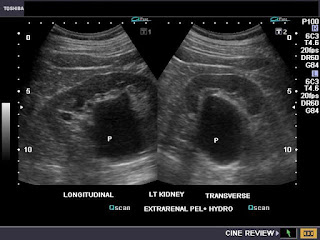Color Doppler and spectral waveform of the fetal middle cerebral artery:
Here is the second video of the MCA:
This Color Doppler video clip demonstrates the exact location of the middle cerebral artery (arrow) among the major vessels of the fetal brain.
Yet another demonstration of the fetal middle cerebral artery (arrow pointing at the vessel) :
Note the high velocity, high resistance flow in this normal fetal middle cerebral artery, with almost no diastolic flow that is very striking about this artery.
The other important fetal vessel that is studied here is the umbilical artery. This spectral Color Doppler waveform video clip shows the normal umbilical artery. The normal umbilical artery shows low resistance flow with high diastolic velocity, which is the opposite of what is seen in the fetal MCA.
The next vessel to be studied in this normal fetus is the most elusive as we mentioned earlier and is the fetal ductus venosus. This color Doppler video /spectral waveform shows the normal ductus venosus with low resistance flow with typically 3 waves seen in spectral display- the S, D and A waves. This vessel is short and disappears from view unless the clinician has a steady hand on the probe and both mother and fetus cooperate.
The Nemio-XG ultrasound machine which I have used for this study has an "update" button which helps to fine tune the spectral video display. This update button has been activated to the later half of this ductus venosus video. The result is obvious, as the waves become smaller and more coherent. Note the almost M-shape of these normal ductus venosus waves. For more on this topic visit: http://www.ultrasound-images.com/fetus-general.htm for more images and case studies of abnormal fetal doppler.
Here is yet another spectral Doppler video tracing of a 34 week old fetus (another case):
Often, this short vessel slips out of view due to fetal movements or maternal breathing. Hence a lot of effort is needed to get optimal color Doppler spectral tracing of fetal ductus venosus.







